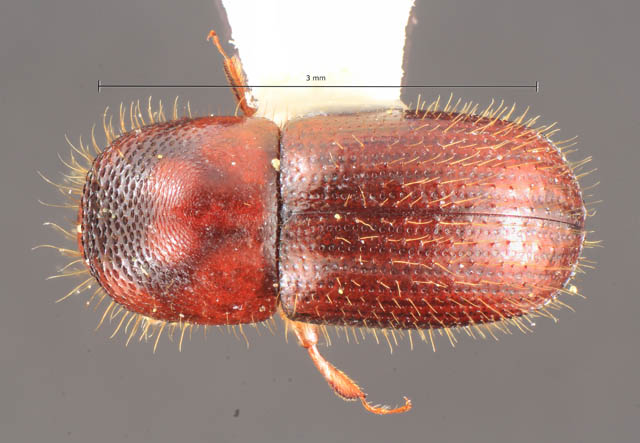Euwallacea interjectus (Blandford 1894) (introduced)


 Images: Displaying 1 to 8 of 14
Images: Displaying 1 to 8 of 14 




 Euwallacea interjectus (female)
Euwallacea interjectus (female) |
 Euwallacea interjectus (female)
Euwallacea interjectus (female) |
 Euwallacea interjectus (female)
Euwallacea interjectus (female) |
 Euwallacea interjectus (female)
Euwallacea interjectus (female) |
 Euwallacea interjectus (female)
Euwallacea interjectus (female) |
 Euwallacea interjectus
Euwallacea interjectus |
 Euwallacea interjectus
Euwallacea interjectus |
 Euwallacea interjectus
Euwallacea interjectus |
| Next > |

Euwallacea interjectus (female) (by TH Atkinson, Biodiversity Center, University of Texas at Austin).
 Summary of Information
Summary of Information





SYNONYMY
- Euwallacea interjectus (Blandford 1894) Trans. Ent. Soc. London 1894: 576
- Xyleborus interjectus Blandford 1894. Trans. Ent. Soc. London 1894: 576
- Xyleborus pseudovalidus Eggers 1925. Sbornik. Faun. Praci Entomol. Oddenleni Narodniho : 159
DISTRIBUTION.
Numbers in parentheses after each geographic unit are the number of distinct collection events in the database for that unit. For exotic species generally only countries are listed for localities outside the New World. For further information on published sources of distribution, check the REFERENCES section.
There are no distribution records in the database
HOSTS
Numbers in parentheses after each host family, genus, or collection method are the number of distinct collection events in the database for that host or method.
REFERENCES
The following are important recent monographs, catalogs, and supplements to catalogs that refer to this species. The specific page on which the reference is made is shown in pink at the end of the reference. In the case of Wood (1982) and Wood & Bright (1992) clicking on the reference page will link to a digital version of the work in question.
- Wood, S.L., Bright,D.E. 1992. A catalog of Scolytidae and Platypodidae (Coleoptera), Part 2. Taxonomic Index. Great Basin Nat. Mem. 13:1-1553 (vol. A, B). [690]
The following are references from which host and distribution data have been input into the database. If one of the above monographs or catalogs also appears in this list, it means that most relevant collection event data have been included.
- Beaver, R.A.; Sittichaya, W.; Liu, L.Y. 2014. A Synopsis of the Scolytine Ambrosia Beetles of Thailand (Coleoptera: Curculionidae: Scolytinae). Zootaxa 3875(1): 1-82.
- Beaver, R.A.; Smith, S.M. 2022. The bark and ambrosia beetles of Bhutan (Coleoptera: Curculionidae: Scolytinae and Platypodinae): a synopsis with three new species of Scolytinae. Zootaxa 5174 (1): 1-24.
- Bright, D.E. 2000. Scolytidae (Coleoptera) of Gunung Mulu National Park, Sarawak, Malaysia, with ecological notes and descriptions of six new species. Serangga 5: 41-85.
- Chapin, J.B., Oliver, A..D 1986. New records for Xylosandrus and Xyleborus species (Coleoptera: Scolytidae). Proc. Entomol. Soc. Wash. 88: 680-683.
- Cognato, A.I.; Hoebeke, E.R.; Kajimura, H.; Smith, S.M. 2015. History of the Exotic Ambrosia Beetles Euwallacea interjectus and Euwallacea validus (Coleoptera: Curculionidae: Xyleborini) in the United States. J. Econ. Entomol. 108(3): 1129-1135.
- EDRR 2011. USFS Early Detection Rapid Response Database. http://www.fs.fed.us/invasivespecies/earlydetection.shtml/.
- EDRR 2014. USFS Early Detection Rapid Response Database. http://www.fs.fed.us/invasivespecies/earlydetection.shtml/.
- Halbert, S.E. 2011. Entomology section. Tri-ology 50(3): 6-9.
- Landi, L.; Braccini, C.L.; Knížek, M.; Pereyra, V.A.; Marvaldi, A.E. 2019. A newly detected exotic ambrosia beetle in Argentina: Euwallacea interjectus (Coleoptera: Curculionidae: Scolytinae). Fla. Entomol. 102 (1): 240-242.
- Park, S.; Smith, S.M.; Cognato, A.I.; Beaver, R.A. 2020. Catalogue of Korean Xyleborine ambrosia beetles (Coleoptera: Curculionidae: Scolytinae) with seven new species. J. Asia-Pacific Biodiv. 13: 210-228.
- Wood, S.L.; Bright, D.E. 1992. A catalog of Scolytidae and Platypodidae (Coleoptera), Part 2. Taxonomic Index (Volumes A,B). Great Basin Nat. Mem. 13: 1-1553.
 Distribution Map
Distribution Map





Maps automatically open at the center of the plotted points and the scale is set to encompass all map points. Maps can be resized (scale bar at upper left) and the center moved (place cursor over map and drag) to see other parts of the distribution of the species. Clicking on a map marker will pull up collection event data and a literature citation if present. If any errors are found, please refer to the "series code" which is a unique identifier for a database record in any communications). Coordinates have not been entered for all collection records. Localities outside the New World are not plotted, even though they are listed in the distribution summary and in the table of records.
There are no distribution records in the database
 Collection Records
Collection Records





There are no distribution records in the database
Return to top of page
